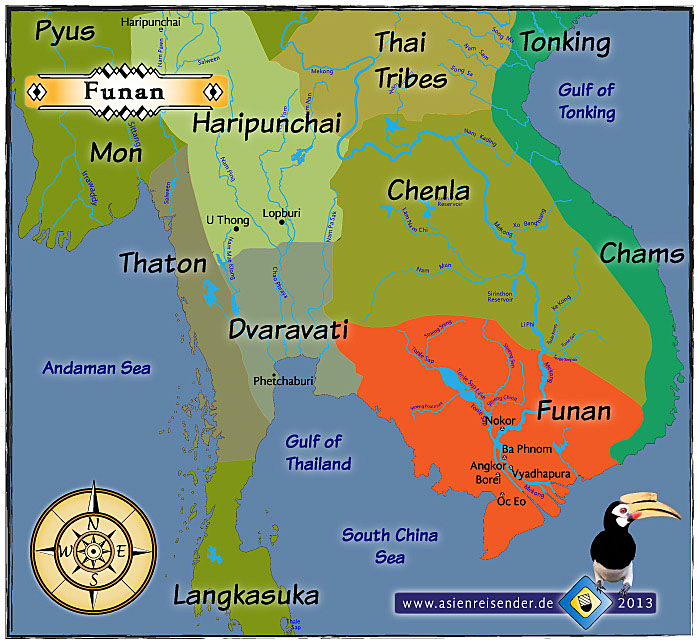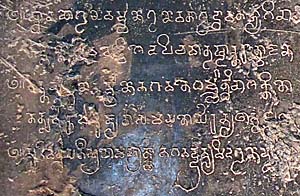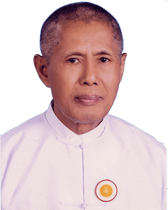The search for Funan leads us back to the very early times of
civilization. Funan is considered as (one of, if not) the first
civilization which took place in
Southeast Asia from the 1
st century CE on, and it was basically located in the fertile mouth of the
Mekong River and the wider area around. It is also part of the first stage of Khmer/
Cambodian history,
for it were probably people of the Indian Khmer/Mon group (or from
Austronesian origin, as other historians argue, or a more mixed-up
multi-ethnic people) who settled down and founded a first settlement of
at least local significance and who evolved technologies who were
furtherly developed and led to the civilization of the classical empire
of
Angkor with the grand architecture of
Angkor Wat and
Angkor Thom and their sophisticated canal system for irrigation and transport.
The lower Mekong area is
inhabited by humans since a long time already. Estimations vary between
tens to hundred thousands of years. What kind of people the first
inhabitants were remains unclear. Probably there was a first immigration
of homo erectus, before homo sapiens followed. Stone-age remains are
the silent witnesses of the presence of these humans.
It's also not clear if these very first people were the ancestors of
the Khmer people, but historians suppose that people from the Khmer-Mon
group lived here since the 3
rd millenium
BCE. However, these first people were nomads, hunter-gatherers who
roamed the forests and along the swampy rivers on the search for game
and edible vegetables. Probably some of these groups of early people
practised a slash-and-burn agriculture as the
hill tribes of
Southeast Asia, for example the Khmer Loeu people of
Cambodia, do still today.
It must have been a long transformation period from the
hunter-gatherer's life to a settlement-based life with permanent
agriculture and animal husbandry. The lower Mekong therefore was a good
base because it's many sidearms provide an abundance of fish as a great
source of proteins and basic food source. Besides, rivers were the first
routes in history, used as waterways.
The usage of copper and bronze tools was invented at around 1500 BCE.
A thousand years later iron tools and weapons were invented (or the
knowledge was imported from India or China) and agriculture had evolved
more efficiently. At this time there were probably a number of petty
principalities in existence, lead by local chieftains. There was no
overheading state existing, unifying these settlements.
As mentioned, the ethnicity of those people is still not clear. There
is no hard evidence that they were Khmer. The first stone inscriptions
done in Khmer language appear from the 7
th
century on. So, it could be that the inhabitants of these early
settlements, including the first larger, state-organized civilization of
Funan, were Chams, or even other people who became extinct later or
were pushed out by a following wave of immigrants.
Map of Funan and other Ancient Civilizations

A medley of Southeast Asia's ancient civilizations
in the first millennium CE. The focus is set on Funan. In the time of
it's largest extend it stretched until deep into the Malay Peninsula
facing the shores of the Andaman Sea / Indian Ocean.
Clear is therefore that the early inhabitants at the beginning of the 1st
century CE were highly influenced by Indian culture. The oldest
civilization which became of overregional influence and left a somewhat
greater amount of traces was Funan. Funan is seen as the first
civilization in Southeast Asia. It can barely be seen as an empire, for it was probably rather an alliance of towns along the lower Mekong River delta than a centralized state. It later spread out it's influence, stretching over greater parts of nowadays Vietnam, Cambodia, Thailand until the borders of Burma/Myanmar and to the Isthmus of Kra.
The parts of Funan far away from the Mekong delta were merely
tributaries. Again, Funan was far away from being an integrated state,
as the term 'state' in it's modern version implies.
Ethnicity

Wat Nokor Bachey's inner temple district. Nokor, situated close to
Kampong Cham, was a former center of the Funan civilization, became centuries later an important place in the
Angkorean
empire and houses now, most prominently in the center of the site, a
contemporary Buddhist temple. Image by Asienreisender, 2013
Some historians suggest that the
regional civilizations were built by waves of immigrants who came from
India. There is no proof for this hypothesis, but it's likely so, for
Funan's close relatedness with Indian culture supports the idea. It's
also likely that merchants from India, Malaya, Java
and China settled down in Funan's towns in the lower Mekong area, who
were of strategical importance as a trade center and stopover on the
seaway between India and China.
Although the ethnicity of the Funanese is unknown, there are hints
that they might have been proto-Khmers. A Funanese king appears in
Chinese records as Fan Shih-Man; though this name is clearly a Chinese
derivate for his original name. If this Fan (Shih-)Man stands for
'Varman' (varman, Khmer = 'protector' as it appears in many later royal
Khmer names) it would be a clear sign for his Khmer ethnicity.
The Funanese religion was dominated by Indian Hinduism, which was
reflected in the typical religious buildings and their architecture
depicting the Hindu cosmos. The Hindu religion was blended with local
superstitions. There were also pieces of early Buddhist art found from
this time.
The Funanese performed the construction of an extended canal system,
what requires an organized, say supplied working force of a bigger size
over a longer time and advanced planning capabilites. These canals were
built rather as a drainage system for an excess of water as a flood
prevention than as an irrigation system as it was later in Angkor.
Funan can be seen as the place where the people made their first large
experiences with canal building, which was later used and sophisticated
in the Angkorean irrigation system. The canals also served as an extended transport system. The Mekong River, it's tributaries and the artificial canals were full with crocodiles at the time, as the Chinese records tell.
Literacy

Part of a sanskrit inscription on a Funanese
stele of the time around 450 CE. It was found in south Vietnam and is to
see in the museum of history in Saigon/Ho Chi Minh City.
The Funanese civilization was a literate one, and Chinese visitors in the 3rd century praised their libraries. The books were written in sanskrit language. But, unfortunately, as it is the case with the Angkorean
literature of later centuries as well, all the Funanese books haven't
stand the test of time. Nothing of it is left, not a single piece.
The Chinese envoy Zhou Daguan in Angkor Thom in 1296/97 reported that the Angkoreans
prepared palm leaves with a black paste as a cover and then scribbled
their writings into it with a bamboo stick or somewhat alike. Might be
that the Funanese already used the same technique.
The Funanese stone inscriptions are written in Indian sanskrit as well.
People's Life and Social Structure
It's even not clear how the Funanese
called themselves; 'Funan' is actually a Chinese word as well. Chinese
chronicals also give record that the Funanese went naked in their towns.
So, the civilizational level apparently wasn't that high.

A simple hut in rural
Cambodia out of
Kampot.
In front of it a canal (covered with lotos flowers) for draining water
away. Many people still live here in similar conditions as their (early)
ancestors did. Image by Asienreisender, 2013
The people lived already somehow similar as they lived over the whole
two thousand years since then and in many cases do still in Southeast Asia.
They built wooden stilt houses and fed from rice, fruits, vegetables
and river fish. At a certain point they started wearing loincloths, and
performed cockfights.
Interestingly historians describe the Funanese society as a very
stratified one. Slavery was an important part of it. So, we can assume
that the Funanese sent armed troops into the wider surroundings of the
settlements to catch and enslave tribal people.
It is also thinkable that there was an established ruling class of
ethnic Indians who dominated over a local population which was
ethnically different. The ethnic Indian element was then reinforced by
waves of immigration, while Indians were placed into key positions of
the state institutions.
There was a rudimentari legal code existing, presumably an idea as
well coming from India. But methods of judgement were barbarious. A
suspect might have been thrown into a river full with crocodiles; if he
survived it, his innocence was proofed. If not - well, served him right,
he was seen as guilty...
Seafaring and Trade
Funan became significant beyond it's
limited borders by having talented seafarers. Funan was in contact via
searoutes and trade networks with far away India, Persia and China.
There have even been Roman coins found in one of Funan's towns, Oc Eo,
who have passed over the long distance, changing through many hands
until they arrived in the Mekong delta.
In later centuries the Funanese payed tribute to the Chinese empire.
Since it's not clear if Funan was a unitary state, the question of it's
capital is hypothetically. If there was a capital, Banteay Prei Nokor (Kampong Cham) is one of the possible locations. Other Funanese locations are Vyadhapura, Angkor Borei, Prey Veng and Oc Eo.
In the 4
th
century Funan fought a war in the Chinese province of Tonkin (nowadays
north Vietnam). Seems they had bad luck there, because from 357 CE on
Funan became a tributary vassal of China.
For the year 539 CE an Funanese king called 'Rudravarman' by the
Chinese appears in Chinese records. He was remarkable for he made the
Chinese emperor the gift of a living rhinoceros. His name also indicates
Khmer ethnicity.
For the time after that the records on Funan are thin.
Many historians believe that the decline of Funan came with the rise
of a rival, Chenla. Chenla's original name is as well unknown as that of
Funan, it's also a Chinese word for a foreign civilization. Though,
there is little known about Chenla as well.
Might be that the decline of Funan was just a relative one, a slow
process, combined with the emerge of other petty principalities.
Nevertheless, it came to an end in the 7
th
century. The people of the time who lived in the Mekong delta can now
clearly be identified as the ancestors of contemporary Khmer people.
In the 8
th century there happened a
Javanese invasion into the Mekong delta region, which brought the Khmer
civilizations there into a vassal status.
According to an Arabic merchant the Javavese sultan Saliendra sent
once an army for punishing a Khmer vassal king, who had provoced him by
demanding his head on a platter. The Khmer king's head was then instead
sent on a platter to
Java.
Source:
http://www.asienreisender.de/funan.html











0 comments :
Post a Comment